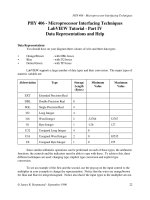Hydrodynamics Advanced Topics Part 4 pptx
Bạn đang xem bản rút gọn của tài liệu. Xem và tải ngay bản đầy đủ của tài liệu tại đây (3.22 MB, 30 trang )
76
Hydrodynamics – Advanced Topics
4
Planar Stokes Flows with Free Boundary
Sergey Chivilikhin
1
and Alexey Amosov
2
1
National Research University of Information
Technologies, Mechanics and Optics,
2
Corning Scientific Center, Corning Incorporated
Russia
1. Introduction
The quasi-stationary Stokes approximation (Frenkel, 1945; Happel & Brenner, 1965) is
used to describe viscous flows with small Reynolds numbers. Two-dimensional Stokes
flow with free boundary attracted the attention of many researches. In particular, an
analogy is drawn (Ionesku, 1965) between the equations of the theory of elasticity
(Muskeleshvili, 1966) and the equations of hydrodynamics in the Stokes approximation.
This idea allowed (Antanovskii, 1988) to study the relaxation of a simply connected
cylinder under the effect of capillary forces. Hopper (1984) proposed to describe the
dynamics of the free boundary through a family of conformal mappings. This approach
was later used in (Jeong & Moffatt, 1992; Tanveer & Vasconcelos, 1994) for analysis of
free-surface cusps and bubble breakup.
We have developed a method of flow calculation, which is based on the expansion of
pressure in a complete system of harmonic functions. The structure of this system depends
on the topology of the region. Using the pressure distribution, we calculate the velocity on
the boundary and investigate the motion of the boundary. In case of capillary forces the
pressure is the projection of a generalized function with the carrier on the boundary on the
subspace of harmonic functions (Chivilikhin, 1992).
We show that in the 2D case there exists a non-trivial variation of pressure and velocity
which keeps the Reynolds stress tensor unchanged. The correspondent variations of
pressure give us the basis for pressure presentation in form of a series. Using this fact and
the variation formulation of the Stokes problem we obtain a system of equations for the
coefficients of this series. The variations of velocity give us the basis for the vortical part of
velocity presentation in the form of a serial expansion with the same coefficients as for the
pressure series.
We obtain the potential part of velocity on the boundary directly from the boundary
conditions - known external stress applied to the boundary. After calculating velocity on the
boundary with given shape we calculate the boundary deformation during a small time
step.
Based on this theory we have developed a method for calculation of the planar Stokes flows
driven by arbitrary surface forces and potential volume forces. We can apply this method
for investigating boundary deformation due to capillary forces, external pressure,
centrifugal forces, etc.
Hydrodynamics – Advanced Topics
78
Taking into account the capillary forces and external pressure, the strict limitations for
motion of the free boundary are obtained. In particular, the lifetime of the configurations
with given number of bubbles was predicted.
2. General equations
2.1 The quasi-stationary Stokes approximation
The equations of viscous fluid motion in the quasi-stationary Stokes approximation due to
arbitrary surface force
f
and the continuity equation in the region
2
GR with boundary
have the form
0
p
x
,
(1)
0
v
x
,
(2)
where
v
v
pp
xx
is the Newtonian stress tensor;
v
are the components
of the velocity;
p
is the pressure;
is the coefficient of the dynamical viscosity, which is
assumed to be constant. The indices
,
take the values 1, 2. Summation over repeated
indices is expected. The boundary conditions have the form
,pn f
x (3)
where
n
and
f
are the components of the vector of outer normal to the boundary and the
surface force. Let
0
be the outer boundary of the region;
(1,2, ,)
k
km
- the inner
boundaries (boundaries of bubbles);
0
m
k
k
- see Fig.1.
Fig. 1. Region
G with multiply connected boundary
Planar Stokes Flows with Free Boundary
79
The free boundary evolution is determined from the condition of equality of the normal
velocity
n
V of the boundary and the normal component of the velocity of the fluid at the
boundary:
,
n
Vvn
x (4)
In case of a volume force
F
acting on G, the equation of motion takes the form
p
F
x
(5)
If the volume force is potential
U
F
x
one can renormalize the pressure
p
pU
and
present (3), (5) in the form
0
p
x
(6)
,
pn f
x (7)
where
f
fUn
is the renormalized surface force.
2.2 The transformational invariance of the Stokes equations
Let’s point out a specificity of the quasi-stationary Stokes approximation (1), (2). This system
is invariant under the transformation
vvVex
(8)
where
V
and
are constants, e
is the unit antisymmetric tensor. Therefore, for this
approximation the total linear momentum and the total angular momentum are indefinite.
These values should be determined from the initial conditions.
2.3 The conditions of the quasi-stationary Stokes approximation applicability
The Navier-Stokes equations
,
p
vv
vF
txx
(9)
where
is the density of liquid, lead to the quasi-stationary Stokes equations (5) if the
convective and non-stationary terms in (9) can be neglected. The neglection of the
convective term leads to the requirement of a small Reynolds number
Re VL
, where V
is the characteristic velocity,
L is the spatial scale of the region G , and
is the kinematic
viscosity. The non-stationary term in the equation (9) can be omitted if during the velocity
field relaxation time
2
TL
the shape of the boundary changes insignificantly, namely
VT L which again leads to the condition Re 1 . The change of the volume force F
and
the surface force
f
during the time T should also be small:
Hydrodynamics – Advanced Topics
80
,,
aa
f
F
TF T
f
tt
(10)
For the forces determined by the region shape (like capillary force or centrifugal force) the
conditions (10) lead to Re 1
again.
The neglection of the non-stationary term is a singular perturbation of the motion equation
in respect of the time variable. It leads to the formation of a time boundary layer of duration
T , during which the initial velocity field relaxates to a quasi-steady state. The condition of a
small deformation of the region during this time interval
00
VT L
is ensured by the
requirement of a small Reynolds number
0
Re constructed from the characteristic initial
velocity
0
V and the initial region scale
0
L .
Let’s integrate the motion equation (5) over the region G and use the boundary condition
(3). As a result we obtain the condition
0.FdG fd
(11)
The equations of viscous fluid motion in the quasi-stationary Stokes approximation (5)
have the form of local equilibrium conditions. Correspondingly, the total force
which
acts on the system should be zero. The same way, using (5) and (3) one can obtain the
condition
0.MexFdGexfd
(12)
where e
is the unit antisymmetric tensor. Therefore, the total moment of force
M
acting
on the system should be zero.
2.4 The Stokes equations in the special noninertial system of reference
Conditions (11) and (12) are the classical conditions of solubility of system (2), (5) with
boundary conditions (3). Let’s show that these conditions are too restrictive. For example,
for a small drop of high viscous liquid falling in the gravitation field the total force is not
zero, but equal to the weight of the drop. Therefore, we cannot use the quasi-stationary
Stokes approximation to describe the evolution of the drop’s shape due to capillary forces.
But in a noninertial system of reference which falls together with the drop with the same
acceleration, the total force is equal to zero.
In a general case, the total force
and total moment of force
M
acting on the system are
not equal to zero. The Newton's second law for translational motion has the form
,
dv
S
dt
(13)
where S is the area of the region,
1
vvdG
S
is the average velocity of the system, and
is the total force. Let’s choose the center-of-mass reference system K
instead of the initial
laboratory system
K . The velocity and coordinate transformations have the form
,,vv v xx x
(14)
Planar Stokes Flows with Free Boundary
81
where
1
xxdG
S
is the coordinate of the center of mass in the initial system K ,
dx
v
dt
. In the new system the surface force is the same as in the initial system
f
f
, but the volume force transforms to FF
and total force is equal to zero:
0
. So, we eliminated the total force
using a noninertial center-of-mass reference
system
K
.
The total moment of force in the new system stays unchanged:
M
M
.To eliminate the
total moment of force
M
we switch from the system K
to the rotating reference system
K
:
,
vvex
(15)
where
is the angular velocity of the rigid-body rotation
,
d
IM
dt
(16)
where
IxxdG
is the moment of inertia of our system. In the new system the surface
force is the same as in the initial system
f
f
, but the volume force transforms to:
2
2,FF ex ev x
(17)
and the total moment of force is equal zero: 0
M
. In case of a small Reynolds number, the
Coriolis force 2
ev
is small compared with the viscous force.
So in case of the total force
and total moment of force
M
not equal to zero we can
eliminate them using the noninertial reference system with the rigid-body motion due to the
force and moment of force.
3. Pressure calculation
Let
and
be smooth fields in the region G related by
2.
xx
(18)
Multiplying the equation of motion (1) by
, integrating over G , and using (2), (3), (18), we
obtain
1
2
p
dG f d
(19)
In the special case when
1
the expression (18) gives us
x
and, according with (19),
1
2
p
dG f x d
(20)
Hydrodynamics – Advanced Topics
82
see (Landau & Lifshitz, 1986 ). In a general case, according with (18),
is an arbitrary
harmonic function and
12
i
is the analytical function associated with
as
didz
(21)
where
is a harmonic function conjugate to
.
The expressions (18) and (19) are basic in our theory. There is also an alternative way to
derive them. The equations of motion (1), continuity (2) and the boundary conditions (3) can
be obtained from the variation principle (Berdichevsky, 2009).
2
1
20
4
pp pdG fvd
(22)
or
1
20
2
pp ppdGfvd
(23)
Since (23) is valid for arbitrary variations of pressure
p
and velocity v
we choose them
such that
p
is left unchanged:
0.
v
v
pp
xx
(24)
In this case (23) gives us
1
0.p pdG f v d
(25)
We introduce the one-parameter family of variations
,
2
vp
. Then (24) and
(25) take the form (18) and (19).
Suppose
N
xR . Then it follows from (18) that
2
20.N
xx
(26)
Therefore, in the three-dimensional case
is a linear function. Only in the two-dimensional
case
can be an arbitrary harmonic function. Formulating in terms of (3.5), only in the two-
dimensional space there exists a non-trivial system of pressure and velocity variations
providing zero stress tensor variation.
The complete set of analytical functions
k
in the region G with the multiply connected
boundary
consists of functions of the form
,
k
o
km
zzz
, where
o
m
z are fixed points, each
situated in one bubble. The complete set of harmonic functions
k
can be obtained in the
form of
Re
k
and Im
k
.
Planar Stokes Flows with Free Boundary
83
According with (1), (2) the pressure
p
is a harmonic function. We present it in the form
.
kk
k
pp
(27)
Using the expression (19) we obtain the algebraic system for coefficients
k
p
:
1
,0,1,
2
kn k n
k
dG p f d n
(28)
4. Velocity calculation
The stress tensor, expressed in terms of the Airy function
,
22
,p
xx xx
(29)
satisfies the equation of motion (1) identically. The boundary conditions (3) take the form
2
,,efx
xx
(30)
where
are the components of the unit tangential vector to the boundary, its direction
being matched to the direction of circulation. Integrating (30) along the component
boundary
k
from a fixed point to an arbitrary one we obtain
,.
kk
efd x
x
(31)
Using (1), (29) and the explicit form of the stress tensor, we get
2,,ddvdxG
x
(32)
where
12
12
21
,,
vv
di pi
xx
(33)
is a harmonic function conjugate to
p
,
2.p
xx
(34)
Therefore
,
nn
n
p
(35)
Hydrodynamics – Advanced Topics
84
where
k
p
are the coefficients of the pressure expansion (27). These coefficients are the
solution of the system (28). According with (32) the velocity in the region G can be presented
in the form
1
,.
2
vxG
x
(36)
The first term in the right-hand part of (36) is the potential part of velocity; the second term
is the vortex part.
The gradient of the Airy function on the boundary was calculated in (31). Then we can
calculate the velocity on the boundary as
1
,.
2
kk
vefd x
(37)
The expression (37) gives us the explicit presentation of the velocity on the boundary.
5. Limitations for the motion of the boundary
5.1 The rate of change of region perimeter
The strong limitation for the motion of the boundary is based on a general expression
regarding the rate of change of perimeter
L . To obtain this expression we use the fact
(Dubrovin at al, 1984) that
,
d
vnHd
dt
(38)
where
n
H
x
is the mean curvature of the boundary. In the 2D case
is the perimeter
of the region, and in the 3D case
is the area of the boundary. We introduce the operator
of differentiation along the boundary
Dn n
xx
. Then we can write (38) in the
form
.
dL
vD nd
dt
(39)
Using the identity
0,
Dd
(40)
where
is an arbitrary field which is continuous on the boundary, and also the equation of
continuity (2) and the boundary conditions (3) we can write (39) in the final form
.
2
d
pfn
d
dt
(41)
Planar Stokes Flows with Free Boundary
85
This expression is valid for any flow of incompressible Newtonian liquid (without Stokes
approximation), generally speaking, with variable viscosity. We will use it for a 2D flow
(
=L is the perimeter of region), in case of constant viscosity:
1
.
2
dL
p
fn d
dt
(42)
5.2 The dynamics of bubbles due to capillarity and air pressure
Let’s take into account the capillary forces on the boundary, the external pressure
0
p
and
the pressure inside of the bubbles
,1,2, ,
kb
p
pk m
, equal in every bubble. Then the
boundary force has the form
,,
kk
n
fn pnx
x
(43)
where
is the coefficient of surface tension. Using (42), (43) we get
00
1
21,
2
bb
dL
pd p L p L m
dt
(44)
where
0
L and
b
L are the perimeter of external boundary and the total perimeter of the
bubbles correspondingly.
Using (20) we obtain
00
,
2
bb
p
dG p S p p S L
(45)
where S and
b
S
are the area of region and the total area of the bubbles.
For
,p
, the expressions (19), (34), (37) give us
2222
00 0 0
0
2
.
bb b b
b
b
p
dG p L p L pd p S p p S
dS
pp
dt
(46)
Using (44) - (46) and the inequality
2
2
1
p
dG pdG
S
we obtain the differential inequality
0
00
2
2
0
1
1.
2
b
b
bb bb
bb
dS
dL
pp
dt dt
pp L ppS
ppS L m
S
(47)
This expression gives us the possibility to obtain the strict limitations for the motion of the
free boundary in some special cases.
Hydrodynamics – Advanced Topics
86
5.3 The influence of capillary forces only
In this case the inequality (47) may be simplified:
2
21.
22
dL L
m
dt S
(48)
where
m is the number of bubbles. Let 2LS
be the asymptotic value of the perimeter
and let
2
t
S
be the dimensionless time. Then, according with (48),
,
up
LL
0
0
0
0
0
0
0
,0,
,1,
111
,2.
11
up
up
up
LLth
Lm
LLth
LL
LLLm
LL
mLLmtgm
Lm
mtgm
(49)
where
up
L
is the upper limitation for time dependence of the perimeter - see Fig.2.
The perimeter of system
L lies in the interval
up
LLL
.
Fig. 2. The upper limitation for the time dependence of the perimeter for various number of
bubbles m .
Therefore, if we have no bubbles in the region, the characteristic dimensionless time of
relaxation of the boundary to the circle
0
1
. In case of one bubble
1m
,
up
LL
at
the time
10
1 LL
. The system with this topology can exist in this time period only.
The bubble must collapse or break into two bubbles in time
*1
. In case of 2m bubbles,
such configuration will exist during the time
Planar Stokes Flows with Free Boundary
87
0
0
1
1
.
1
1
m
mLL
arctg
LmL
m
(50)
5.4 Bubbles in an infinite region
The outer boundary of the region is a circle with a large radius R . The bubbles are localized
around the center of the circle. Using the expressions
2
,2
bb
RSSL RL
, we can
see that the inequality (47) in the limit R takes the form
2
0
,
b
dW
pp
Wm
dt
(51)
where
0bbb
WL
pp
S
. Therefore, at
0
0
b
pp
22
0
00
(0) exp .
b
bb
pp
mm
WW t
pp pp
(52)
Because 0W , this configuration exists without change of the number of bubbles during
the time
0
0
2
0
ln 1 0 0 .
b
bbb
b
pp
tLppS
pp
m
(53)
6. Motion of the boundary due to capillary forces
6.1 Calculation of pressure and velocity
In case of capillary forces action
,
n
fn x
x
(54)
and expression (19) takes the form
,
2
p
dG d
(55)
or
,
GG
pp
(56)
where
11
,,.
2
G
G
ffdGffdP
SL S
(57)
The expression (56) is valid for any harmonic function
. Let’s apply
p
. Then we obtain
2
,
G
G
ppp
(58)
Hydrodynamics – Advanced Topics
88
It can be seen from (58) that
.pp
(59)
Introducing the generalized function (simple layer)
() ,
s
dl
y
xxy (60)
we see that p is the projection of
s
onto the subspace of harmonic functions.
Introducing in G a complete system of orthonormal harmonic functions
0
k
k
which
obey the orthogonality condition
kn kn
G
, we obtain from (56) the following
expression for the pressure
0
.
kk
G
k
pp
(61)
In case of capillary forces the expression (37) takes the form
1
,.
2
vn x
(62)
6.2 Relaxation of a small perturbation of a circular cylinder
Consider a small perturbation of the circular cylinder boundary, given by
,rRh t
,
hR . Then we have from (62)
exp ,
2
k
k
h
kikh
tR
(63)
2
0
() exp , (0)exp ,
22
kk
kt
d
ht ik h t h
(64)
in agreement with (Levich, 1962). According with (64), a small boundary perturbation of
characteristic with aR
and amplitude Ha
has a characteristic decay time
~
a
.
6.3 The capillary relaxation of an ellipse
Let’s test our theory on an example of a large amplitude perturbation. We calculate the capillary
relaxation of boundary with initial shape
22
12
22
1
xx
ab
in two ways - using the numerical
calculation based on (6.4) and the finite-element software ANSYS POLYFLOW (see Fig. 3 and
Fig.4). These methods of calculation give us the same results with discrepancy about 1%.
6.4 The collapse of a cavity
Let’s now consider a large amplitude perturbation in the shape of a cavity (Fig. 5). By
symmetry, the pressure must be an even function with respect to
2
x
, i.e.
12 12
,,
p
xx
p
xx .
Planar Stokes Flows with Free Boundary
89
Fig. 3. Computational domain used in finite-element calculation of ellipse relaxation.
Fig. 4. Relaxation from ellipse to a circle in finite-element calculation.
We introduce a space of two-variable harmonic functions which are even with respect to the
second argument, and choose in it the complete system of functions in the form
cos
n
n
rn
(
r
and
are the polar coordinates in the
12
,xx plane). Since the width
is small
2
2( 1)
n
mn
mn
g
R
n
. Then the complete system of orthogonal harmonic
functions in this space is
2( 1) cos .
n
n
r
nn
R
(65)
Inserting (65) in (61) and summing the series yields
22
121
Re ,
HRH
p
RRz
RRRHR
(66)
Hydrodynamics – Advanced Topics
90
Fig. 5. Cavity perturbation.
whence, using (35), we have
2
2
1ln .
RRHz
Hz
RR R HR
(67)
In spite of the logarithm, (67) is a single-valued analytical function in G , because the
boundary perturbation constitutes a branch cut. If we insert (67) in (62), we find that the
normal velocity of the cut edges
2
V
(in the zero approximation with respect to the small
parameter
H
). The edges close up after a time
. Although capillary forces generally
tend to flatten the boundary perturbation, in this case they produce the opposite effect.
Acting to reduce the length of the cut, the capillary forces generate a flow of scale
H in the
region. The velocities along
1
x
and
2
x
have the scales H
and
, respectively. If we equate
the work of surface-tension force with the rate of energy dissipation by viscous forces, we
find that
2
2
H
HH
H
or H
; this conforms to the rigorous result we
obtained before.
Planar Stokes Flows with Free Boundary
91
7. Conclusion
We presented a method to calculate two-dimensional Stokes flow with free boundary, based
on the expansion of pressure in a complete system of harmonic functions. The theory forms
the basis for strict analytical results and numerical approximations. Using this approach we
analyse the collapse of bubbles and relaxation of boundary perturbation. The results
obtained by this method are correlating well with numerical calculations performed using
commercial FEM software.
8. Acknowledgment
The authors would like to express their sincere gratitude to Prof. V. Pukhnachov and Prof.
C. Pozrikidis for their attention to this research.
9. References
Antanovskii, L.K. (1988).Interface boundary dynamics under the action of capillary forces.
Quasisteady-state plane-parallel motion.,
J. Appl. Mech. and Techn. Phys. Vol. 29, No
3, pp. 396-399.
Berdichevsky, V. (2009).
Variational principles of continuum mechanics, Vol. 1, Springer-Verlag,
Berlin-Heidelberg
Chivilikhin, S.A. (1992). Plane capillary flow of a viscous fluid with multiply connected
boundary in the Stokes approximation,
Fluid Dynamics, Vol. 27, No. 1, pp. 88 - 92.
Frenkel, J. (1945). Viscous flow of crystalline bodies under the action of surface tension,
Journal of. Physics, Vol. 9, No. 5, pp. 385-391
Dubrovin, B.A., Fomenko, A.T. & Novikov, S.P. (1984).
Modern Geometry. Methods and
Applications.
Part 1. Springer–Verlag
Happel, S.J. & Brenner, H. (1965).
Low Reynolds Number Hydrodynamics, Prentice-Hall,
Englewood Cliffs
Hopper, R.W. (1984). Coalescence of two equal cylinders: exact results for creeping
viscous plane flow driven by capillarity,
J. Am. Ceram. Soc., Vol. 67, No. 12, pp.
262 - 264.
Ionesku, D.G. (1965). Theory of analytic functions and hydrodynamics,
in: Applications of the
Theory of Functions in the Mechanics of Continuous Media
, Vol. 2, Mechanics of
Liquids and Gases [in Russian], Nauka, Moscow.
Jeong, J T. & Moffatt, H.K
. (1992). Free-surface cusps associated with flow at low Reynolds
number,
J. Fluid Mech., Vol. 241, pp. 1-22.
Landau, L.D. & Lifshitz E.M. (1986). Theory of Elasticity. Course of Theoretical Physics.
Vol.7. Butterworth-Heinemann.
Levich, V.G. (1962).
Physicochemical hydrodynamics, Prentice-Hall, Englewood Cliffs, New
Jersey
Muskeleshvili, N.I. (1966).
Some Fundamental Problems of the Mathematical Theory of Elasticity
[in Russian], Nauka, Moscow
Pozrikidis, C. (1997). Numerical studies of singularity formation at free surfaces and fluid
interfaces in two-dimensional Stokes flow,
J. Fluid Mech. 331, pp. 145-167.
Richardson, S. (2000). Plane Stokes flow with time-dependent free boundaries in which the
fluid occupies a doubly-connected region,
Eur. J. Appl. Math., 11, pp. 249-269.
Hydrodynamics – Advanced Topics
92
Tanveer, S. & Vasconcelos, G.L. (1994). Bubble Breakup in two-dimensional Stokes flow,
Phys. Rev. Lett., Vol. 73, No. 21, pp. 2845-2848.
Part 2
Biological Applications and Biohydrodynamics
5
Laser-Induced Hydrodynamics in Water
and Biotissues Nearby Optical Fiber Tip
V. I. Yusupov
1
, V. M. Chudnovskii
1
and V. N. Bagratashvili
2
1
V.I. Il`ichev Pacific Oceanological Institute, Far Eastern
Branch of Russian Academy of Sciences
2
Institute of Laser and Information Technologies,
Russian Academy of Sciences
Russia
1. Introduction
This paper is aimed at revealing the mechanisms of therapeutic effects stimulated by a
medium power (1–10 W) fiber laser induced hydrodynamics in water-saturated bio-tissues.
Modern laser medical technologies widely employ delivery of laser light to irradiated tissues
via optical fibers. Optical fiber easily penetrates through needle and endoscopic channels, and
laser light can be delivered through a fiber for puncture and endoscopic operations. Several
laser medical technologies (puncture multichannel laser decompression of disc, laser
intervention upon osteochondrosis, surgical treatment of chronic osteomyelitis, endovenous
laser ablation, etc.) are based on effective hydrodynamic processes in water-saturated bio-
tissues. These hydrodynamic processes trigger cellular response and regenerative effects
through the specific mechanisms of mechano-biology. In this work, we consider different
kinds of effects stimulated by a medium power laser-induced hydrodynamics in the vicinity of
a fiber tip surface, in particular, generation of vapor-gas bubbles, fiber tip degradation, and
generation of intense acoustic waves. Presence of strongly absorbed agents (in a form of Ag
nanoparticles, in particular) in laser irradiated water nearby optical fiber tip results in
appearance of pronounced filamentary structures of these agents.
2. Therapeutic motivation
One of the modern tendencies in a low-invasive medical therapy is a medium power (1–10
W) laser treatment of connective tissues. The examples of such technologies are: laser
engineering of cartilages (Bagratashvili et al., 2006); puncture multichannel laser
decompression of disc (Sandler et al., 2002; Sandler et al., 2004); laser intervention upon
osteochondrosis (Chudnovskii & Yusupov, 2008); laser treatment of chronic osteomyelitis
(Privalov et al., 2001); endovenous laser ablation (Van den Bos et al., 2009); fractional
photothermolysis (Rokhsar & Ciocon, 2009).
Treatment of osteochondrosis, for example, is based on laser-induced (0.97 µm in
wavelength and 2–10 W in power) formation of multiple channels inside an intervertebral
disc using silica fiber with a carbon coated fiber tip surface, in order to enhance laser light
absorption nearby the fiber tip. Osteochondrosis is caused by such partial destruction of
Hydrodynamics – Advanced Topics
96
intervertebral disc, followed by release of nucleus pulposus from disc in the form of hernia,
which exerts pressure upon nervous roots thus giving pain. Fig 1а shows the scheme of
formation of multiple laser channels inside intervertebral disc in the course of laser
treatment of osteochondrosis (Sandler et al., 2002; Sandler et al., 2004; Chudnovskii &
Yusupov, 2008). Transport laser delivery fiber passes inside the disc under treatment
through a thin needle inserted to the disc (laser puncture procedure). Optical fiber is
inserted through a thin needle via a posterolateral percutaneous approach under a local
anesthesia. Important, that saline water is permanently introduced into the disc through the
needle. Channel is formed by the heated fiber moving forward inside the disc. The fiber
forms the channel and is shifted 1 -2 cm per 5 – 10 s inside the disc. Fig. 1b shows the
example of such channels in nucleus pulposus of spinal disc formed by a fiber laser in the
course of laboratory experiment (Sandler et al., 2004).
Fig. 1. a - Scheme of laser irradiation of spinal disc. b – Laser channel formed in spinal disc
through optical fiber in presence of physiological solution (Sandler et al., 2004).
Surprisingly, that such action on herniated disc causes significant effect in some period of
time on tissues located out of laser irradiated zone. As one can see, for example, on
tomography picture (Fig. 2b), some cavities appear in the hernia, and its density decreases
significantly compared with the density of hernia before laser treatment (Fig. 2a).
Fig. 2. Computer tomography pictures of herniated disc area. a– before healing: big
sequester of hernia (side view); b - cavity inside hernia, stimulated by laser-induced channel
formation in disc; с –three month after laser healing : no hernia.
Laser-Induced Hydrodynamics in Water and Biotissues Nearby Optical Fiber Tip
97
As a result, the hernia transforms into a soft sponge, the pressure of hernia on nervous roots
decreases, and relevant pain releases. The hernia itself disappears after some period of time,
and regenerative processes take place which result (in a few month) in recovery of the disc
structure and their main functions (Sandler et al., 2002, 2004; Chudnovskii et al., 2008, 2010a,
2010b).
Another important example of a medium power laser therapy is a laser treatment of chronic
osteomyelitis. Fig. 3а demonstrates the X-ray image of femoral bone of the 14 year old
patient heavily affected by osteomyelitis (Privalov et al., 2001). Significant destruction and
rarefication of bone structure takes place. Typically, such bone tissue degradation requires
amputation of organ. However, application of medium power laser treatment approach in
this case gave, as a result, a complete regeneration of affected femoral bone (Fig. 3b), and no
amputation was required. Again, therapy was based on a medium power laser-induced
formation of channels (similar to that presented at Fig.1) in a bone medullary tissue, which
stimulate successively the regeneration processes in the bone tissue.
Fig. 3. X-ray images of right hip of the 14 y.o. patient with chronic osteomyelitis (Privalov et
al., 2001). a - destruction and rarefication of bone structure before treatment. b - complete
regeneration of bone structure 11 month after laser treatment.
Strong regenerative potential of medium power laser treatment for different kinds of tissues
is already well recognized (Sandler et al., 2002, 2004; Chudnovskii & Yusupov, 2008,
Chudnovskii et al., 2010a, 2010b), however the dominant primary physical mechanisms of
such regeneration are still the subject of controversy. It is commonly accepted that the effects
of medium power laser irradiation result from laser heating of tissues. However in most of
cases, the pronounced therapeutic effect cannot be rationalized by laser-induced thermal
tissue degradation only. For example, appearance of cavities in the hernia and significant
decrease of its density observed immediately after laser manipulation (Fig. 2b), takes place
without its heating, since hernia is located quite far from the area of laser-induced channel
formation, and, thus, heating of hernia is negligible.
Hydrodynamics – Advanced Topics
98
We believe that effective hydrodynamic processes play dominant role for the effect of a medium
power laser-induced regeneration and healing of connective tissues diseases (intervertebral
hernia, osteomyelitis and some other diseases) using laser puncture procedures
(Chudnovskii & Yusupov, 2008; Chudnovskii et al., 2010a, 2010b). Main features of these
processes will be considered below.
3. Laser-induced generation of micro-bubbles in water
The key process for the mechanism of medium power laser-induced regeneration and
healing of musculoskeletal system diseases is the generation of micro-bubbles in inter-tissue
water (Yusupov et al., 2010).
3.1 Laser-induced generation of micro-bubbles in a free water
Formation of micro-bubbles in a free water was studied with the aid of the optical methods
using a water filled plastic cell (the horizontal dimensions are 150 × 100 mm and the height
is 15 mm) and glass capillaries with an inner diameter of 1 mm. In the most of experiments,
the working fiber tip is preliminary blackened by a short (~1 s) contact of the fiber tip with a
wooden plate at a laser power of about 3 W. The fiber tip surface thus covers by a thin
carbon layer owing to the wood burning. Such a procedure is well reproduced, so that from
10 to 20% of the laser power is absorbed in the thin carbon layer. Computer controlled fiber
lasers (LS-0.97 and LS-1.55 of IRE–Polus, Russia) with the wavelengths of 0.97 μm and 1.55
μm, 1–10 W in power were interfaced with a 400 μm core diameter silica fiber. Low intensity
(up to 1 mW) green pilot beam from the built in diode laser was used to highlight the laser
irradiated zone in the cell. The fiber is horizontally fixed in the cell, which is placed on the
worktable of a MICROS MC300 microscope equipped with a Vision digital color camera
interfaced with PC. The water cell was also placed on the table with illumination, and the
processes in the vicinity of the heated fiber tip were visualized using a Photron Fastcam SA-
3 camera at rates of 2000 or 10000 frames per second. To control the laser induced spectrum,
an Ocean Optics USB4000 fiber spectrum analyzer was used, which is interfaced with PC
and has an optical resolution of about 1.5 nm and 200–1100 nm wavelength range. For better
visualization of hydrodynamic flows the collargol (albumin coated Ag nanoparticles) have
been added to water in the cell (Yusupov et al., 2011b).
Hydrodynamic flows taking place nearby the fiber tip when laser power is on, can be clearly
seen in a scattering mode using illumination with green light of pilot laser beam through the
same transport fiber (Fig. 4). Such flows result in intrusion of collargol from neighboring
area into the area in front of the fiber tip. One can also see here the initial process of new
intrusion formation (outlined with a dashed line). The rate of rise-up front of a given
intrusion (which is about 150 μm in average thickness) is found to be described by
exponential low (Yusupov et al., 2011b)
0.6 exp( 1.5 )
Vr, (1)
where r is the distance from fiber tip: at 1 mm from fiber tip V = 150 μm/s, while at 2 mm
from fiber tip V falls down to 30 μm/s.
The bubbles don’t occur up to laser power of 10 W with non-blackened fiber tip and for 0.97
μm laser radiation, while for 1.56 µm laser radiation (which is much stronger absorbed by
water) the bubbles are generated at about 1 W of laser power. Blackening of fiber tip results
in generation of bubbles for both 0.97 µm and 1.56 µm laser wavelengths.
Laser-Induced Hydrodynamics in Water and Biotissues Nearby Optical Fiber Tip
99
Fig. 4. Microscope pictures (in scattering mode) of intrusions of Ag nanoparticles in water
(outlined with dashed line) stimulated by laser induced hydrodynamics nearby optical fiber
tip at 1.0 W of 0.97 µm laser power in 6 s (a), 12 s (b), and 18 s (c) of laser irradiation. Fiber
tip is shown by dashed line (Yusupov et al., 2011b).
Energy of incident laser light is partly (10–20%) absorbed by the carbon layer on the
blackened fiber, so that the fiber is heated. When laser radiation with a power of greater
than 3 W is transmitted by the fiber tip in air, the spectrum of the optical radiation from the
fiber tip contains the fundamental line (0.97 µm or 1.56 µm) and the broadband visible and
near-IR radiation caused by the heating of the tip surface to relatively high temperatures.
When a blackened tip is placed into water, the tip surface is effectively cooled and the
absence of the broadband radiation means the substantially lower temperatures of the tip
surface. However, a medium power laser radiation (1–5 W) is sufficient for surface heating
and generation of vapor-gas bubbles. When water is heated, the dissolved gases are
liberated in the vicinity of the tip surface and gas bubbles emerge. Water is evaporated
inside the bubbles, so that the bubbles are filled with vapor and, consequently, increase in
size. At the lower boundary of the above power interval, the bubbles increase in size
residing on the tip surface (Fig. 5a). When a critical size is reached, the bubbles are detached
and move to the surface.
Water molecules which approach the heated tip surface acquire additional kinetic energy
and momentum. The component of the total momentum of vapor molecules that is directed
perpendicularly to the tip surface of the fiber towards water appears insufficient for the
detachment of the bubble. Figure 5a shows that the bubbles sizes can be close to the
diameter of the silica fiber core (400 µm). In the experiments, the bubbles normally emerge
at same spots on a tip surface, which correspond to a high temperature areas. Evidently, the
presence of such spots is related to the nonuniformity of the carbon layer: the absorbed
energy (and, hence, the temperature) is greater for thicker regions. The stabilization (i.e., the









